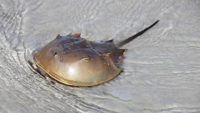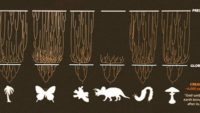What should we think about phosphine in Venus’s clouds? Why do all living creatures use phosphate? …read more Source:
Shaun Doyle talks to Tim Clarey about his research career in Flood geology. …read more Source: creation.com
The standard theme often given for Viking history is that of blond-haired, blued-eyed, burly men exploring, trading, ransacking, and pillaging across Europe, Asia, and the North Atlantic. While historical Viking exploits still entertain history buffs, a pervasive study of DNA extracted from the bones of their burial sites is overturning the idea that a fair Scandinavian complexion was the norm among these people.1 The ac… More… …read more Source: icr.org
By Dr. Gordon Wilson Scorpions appear armed to scare and kill. Are we supposed to be afraid, or is it just our imagination? …read more Source: AIG Daily
By Troy Lacey The strange and unique horseshoe crab demonstrates design and yields medical benefits to humans and pets. …read more Source: AIG Daily
Is a tiny lump on the rim of some human ears evidence for evolution? …read more Source: creation.com
These recently discovered tracks at the Grand Canyon show yet more strong evidence for a massive watery catastrophe. …read more Source: creation.com
By Ken Ham Emerald, aquamarine, topaz, zircon, and garnet are well-known gemstones. Also, lithium is used in batteries, like those found in an electric car. These minerals, and others, are found in “pegmatites, veinlike formations that commonly contain both large crystals and hard-to-find elements.” Many of these crystals are quite small, while others can be very large. How are they formed? And does it take long ages? Well, as one researcher says, “The idea is that large crystals take time to grow.” But is that accurate? Over and over again the assumptions of slow-and-gradual processes over long periods of time [More]
Is the Tibetan snow lotus evolving to elude detection? …read more Source: creation.com
Have engineers actually designed a super material that cannot be cut? And where did they get their inspiration? …read more Source: creation.com
Tim Clarey, Ph.D., and Jake Hebert, Ph.D. Secular scientists continue to struggle to explain the origin of Earth’s water. And a new study published in Science calls into question their previous assumptions and earlier expectations.1 By comparing the chemistry of a rare kind o… More… …read more Source: icr.org
It’s argued that peer review demonstrates that creation science is not science at all but merely an outmoded faith without evidence to back it up. …read more Source: AIG Daily
The cell cycle is complex and unique to larger domains of life. Mutations do not help the cell cycle but rather lead to cancer. …read more Source: creation.com
Jeffrey P. Tomkins, Ph.D., and Tim Clarey, Ph.D. Fossil pollen, leaf and fruit impressions, and petrified wood taken from multiple locations across the massive Central Andean Plateau in South America reveal powerful evidence of the global Flood recorded in the Bible. These fossils also provide strong evidence that Flo… More… …read more Source: icr.org
Secular scientists are obsessed with attempting to show that life on Earth is not unique and therefore must exist, if not elsewhere in our solar system then somewhere in our Milky Way Galaxy. It is this worldview that resulted in the fruitless, decades-old project called the Search for Extraterrestrial Intelligence (SETI). It began with much anticipation and fanfare, but today has yet to reveal life or intelligent signals beyond Earth.More… …read more Source: icr.org
By Dr. David Menton Evolutionists at Flinders University report that a growing number of babies are born without their wisdom teeth and claim this shows that humans are evolving at their fastest rate. …read more Source: AIG Daily
In 2020, Hungarian zoologists described the hybridization of a Russian sturgeon and American paddlefish.1 Some sources have reported the scientists created a “franken-fish”—as indeed it looks quite bizarre.2 Researchers, however, are calling it the sturddlefish—with sharp fins and an elongated nose.3 A hybrid in zoology is an offspring produced from a cross … More… …read more Source: icr.org
By Dr. Terry Mortenson Examining the immense biblical data for Noah’s flood as an actual, year-long, worldwide, and catastrophic flood about 4,500 years ag …read more Source: AIG Daily
Ruffling the feathers of dinosaur evolution. …read more Source: creation.com
How has the alleged evidence for evolution changed in the past 50 years? How has it stayed the same? …read more Source: creation.com
The preserved carcass of a “prehistoric” cave bear has been discovered in melting permafrost on an Arctic Russian Island.1,2 Reindeer herders discovered the remains of the adult cave bear on Bolshoy (or Great) Lyakhovsky Island, part of the New Siberian Islands off the coast of northern Russia.2 This is the first time that a whole bear carcass with preserved soft tissues has been discovered. Even the bear’s… More… …read more Source: icr.org
Long-age icon created in weeks …read more Source: creation.com
What can the famed character Ian Malcolm from Jurassic Park teach us about forensic investigations and historical science? …read more Source: creation.com
By Ken Ham Evolutionists believe anatomically modern humans evolved some 200,000–300,000 years ago. And yet they also believe that “complex technology and cultures” evolved only 50,000 to 65,000 years ago . . . with agriculture only arriving a mere 10,000 years ago. So what were humans doing for those supposed tens of thousands of years? Well, a recent article attempts to answer that question by arguing that, while fossils and DNA show that humans had the brains to do everything we can do today, supposed early humans didn’t develop tools, culture, or any form of complex technology for tens of [More]
By Dr. Gary Parker We still see God’s creativity unfolding before our very eyes in a different way in the birth of each child. …read more Source: AIG Daily
One marvellous characteristic of living things is the ability to respond to their environment in a way that sustains life and allows for procreation. This is clear evidence of a wise Creator who blessed living creatures to reproduce and fill the earth (Genesis 1:21–22, 27–28; 8:17; Isaiah 45:18). Of great interest to creation biologists is the underlying design that has enabled living creatures to adapt to numerous, varied environments in a bit over 4,300 years since the Flood.. …read more Source: creation.com












































